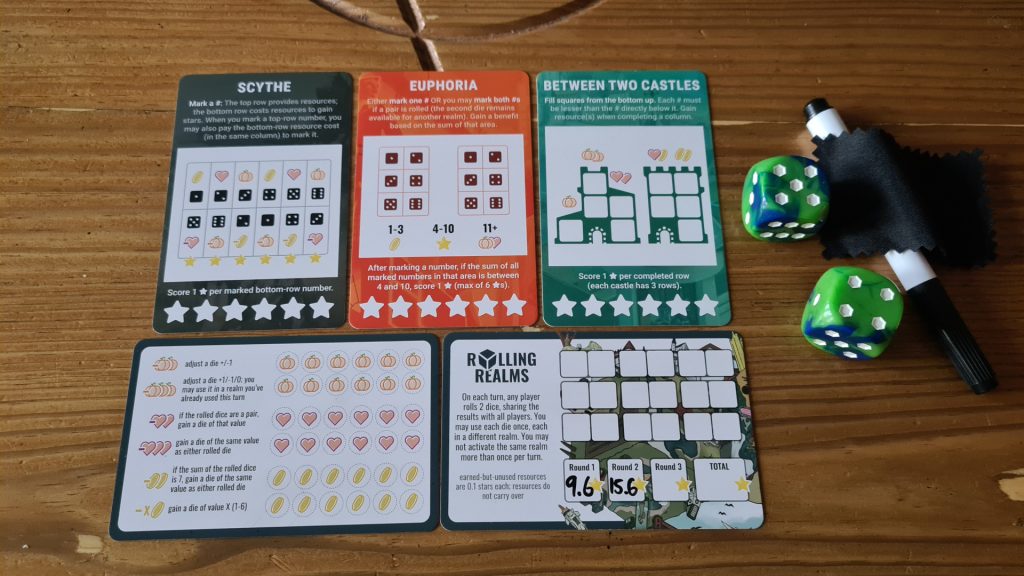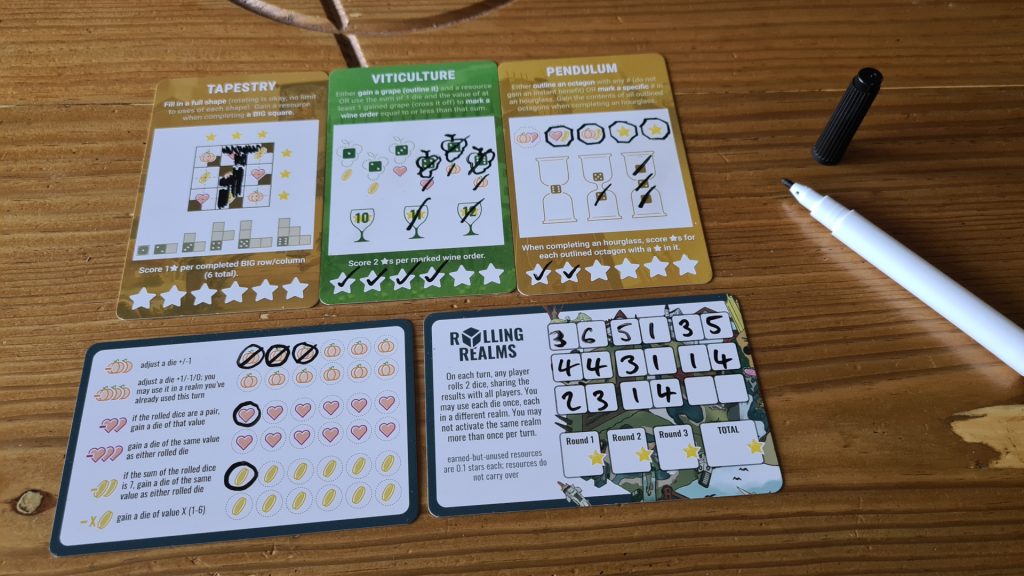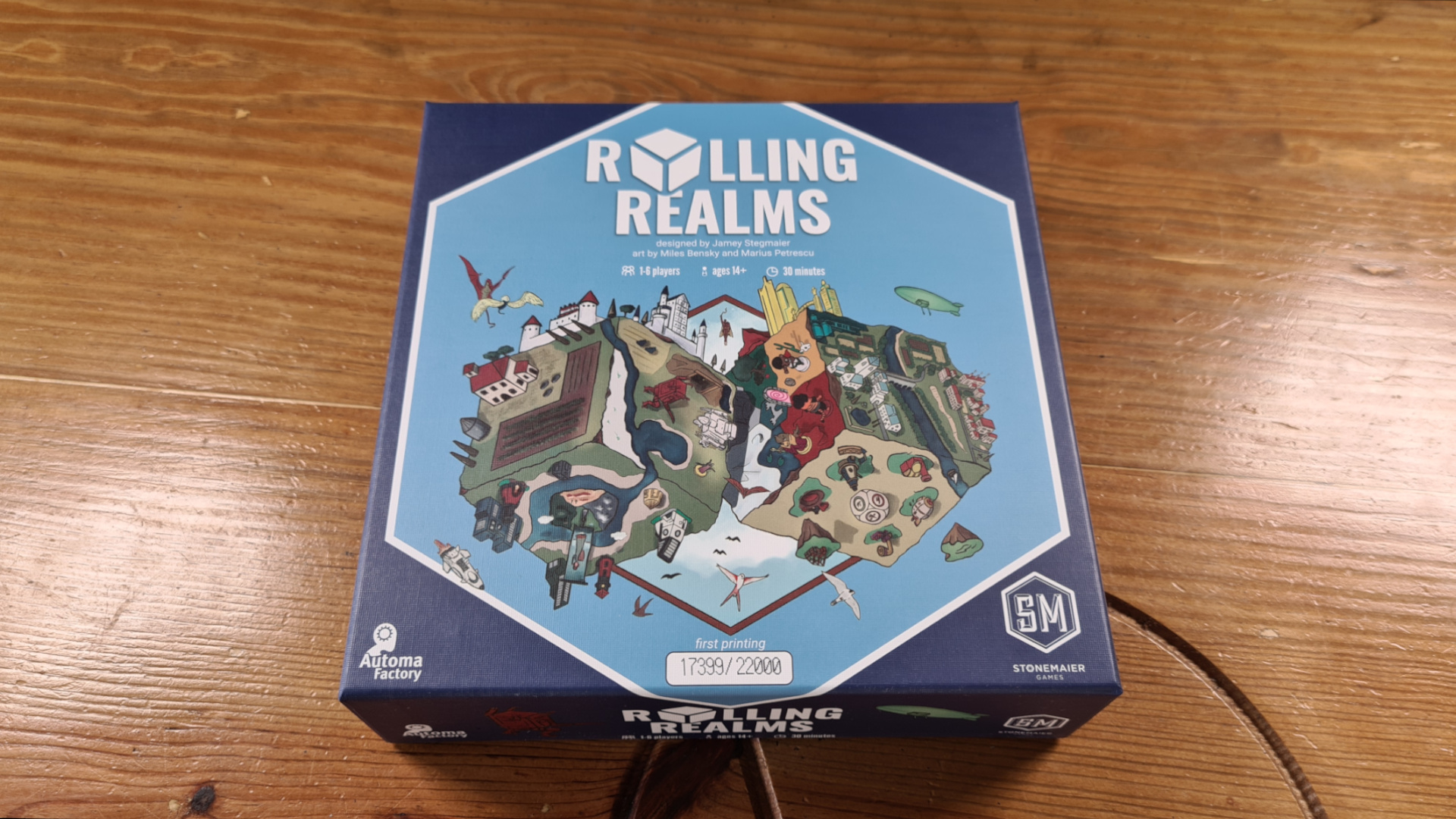Rolling Realms started out as a print and play project from designer Jamey Stegmaier, during the height of the coronavirus. Coming out of the time of self-isolation the game was created, and is now a fully published game from Stonemaier Games, which features artwork from Marius Petrescu and Miles Bensky. Rolling Realms sees 1 – 6 players utilize the results of two dice across multiple realms, which are small snapshots of Jamey’s other much loved board games; including the likes of Viticulture, Scythe and Tapestry. However, is it another hit from Stonemaier Games? Let’s find out!
Rolling Realms is played out over 3 rounds. In each round players will use 3 realm cards. Giving everyone a matching deck of 11 realm cards, a resource card and a score card, one player shuffles their deck of realms, drawing the 3 realms to be used. All players then take these same 3 realms from their deck to use that round. Everyone grabs a pen to write onto their cards and the two dice can be given to any player. Then, the game is ready to begin.
Each round the two dice are rolled a total of nine times. Each time, the numbers rolled are recorded by players on their score card, before being utilized on their realms. By default the player must choose a different realm for each die roll that turn. Therefore, if they had the Society, Viticulture and Between Two Cities realms in front of them with a 3 and 4 rolled, they couldn’t normally use both dice on Society. They would have to split them, potentially using the 3 on the Viticulture realm and the 4 on the Society realm. All players use the same dice roll, though are free to use the numbers as they wish on their realms – regardless of what the other players choose to do.
Each of the realms works rather differently, taking cues and mechanical inspiration from the game they represent. The Scythe realm, for example, has dice values on top and bottom actions. Though, if a player spends a die to activate a top row they may also activate the bottom row without a second die. In this case the top row of Scythe’s realm gains players resources (pumpkins, hearts or coins) while the bottom row spends resources to pay for stars – stars being the points of the game.

Some realms see the number rolled and used written onto a box of the card. For the Wingspan realm players write numbers into the boxes from left to right; triggering them to gain resources and stars. At the end of the round if the numbers written add up to the wingspans additional stars are earnt. Not every realm does this though, with the Tapestry realm converting the number into a shape which can be drawn onto a slowly filled in map, akin to the capital city mats in actual Tapestry.
The resources players collect within a round can be extremely powerful boosts. Pumpkins can be spent to adjust the value of a die result just for you, with 3 pumpkins even allowing the player to write a number into an already used realm. Hearts can be spent to gain extra dice, either 2 if a pair is rolled or 3 to pick either rolled number to use again. Coins can be used if the total result of the dice is a 7 to duplicate a die or spent to gain an extra die, the value based on the number of coins spent.
At the end of a round players count up their stars. Before rubbing off the resources from their trackers, players gain 0.1 star per unspent collected resource. No resources are carried over between rounds, but at least they get you those important decimal points. If it’s not the end of the third round then the game moves onto the next round. The used realm cards are discarded and a new 3 are randomly chosen – the same ones again for all players. At the end of the third round whoever has the highest total wins!
During the first play of Rolling Realms there is that extra bit of brain burning, from learning the realm cards as they come out of the deck. This is when players determine how they each work and how to score for that realm. In subsequent games, this issue ebbs away, not making Rolling Realms necessarily an easy game. Still, it does at least allow players to focus on how to score big rather than just how to score.

While they aren’t completely thrown at players, resources aren’t overly hard to come by. Some realms, suchs as Euphoria or My Little Scythe, are even designed to gain players resources faster than others. It’s through these resources where most of the luck mitigation is handled. From bonus dice to manipulating the values of dice, these resources give some control back to the players, regardless of if the rolls are good or bad. This makes the experience feel much more tactical, than fully at the hands of the dice gods.
If there is one element that makes it seem more gamery than perhaps Rolling Realms actually is, it’s the decimal points part of the scoring. These aren’t unnecessary either, as it makes gaining and spending resources much more important and the choices around them more meaningful. There’s no getting around it looking more difficult as a result though, as decimals have put some off – before explaining during play there’s no complicated maths to do.
Any roll and write which comes with drywipe pens are already above most in terms of production quality. Then, players are actually writing on the realm cards themselves, which feels almost wrong to do (in a good way). There isn’t stunning artwork to back this component quality up, though the UI of the cards is kept clean, easy to read, with simple to understand iconography. A great touch is that each card has a description of the way the realm card works and scores. So, there’s no need to keep reaching for the rulebook, despite each realm being unique.
Rolling Realms manages to be rather meta, in terms of being small nods to all of Stonemaire’s other games, and yet still feel like its own experience. Play for the majority of the rounds goes fast, with everyone simultaneously using the dice on their own realms, writing onto the lovely realm cards. At the end of each round there’s a bit of a crunch where players try to utilize those final few dice to the best of their ability. After one playthrough Rolling Realms felt a little too much. With each subsequent play that experience has improved – becoming a solid go-to roll and write in the process!
(Editor’s Note: Rolling Realms was provided to us by Asmodee for the review. The game is currently available from local board game stores! Find your local store here.)

